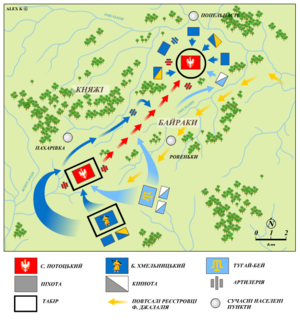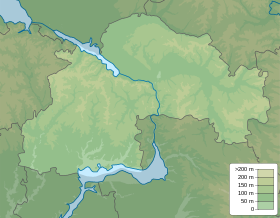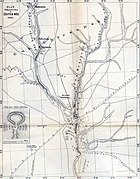Battle of Schowti Vody
| date | April 29, 1648 to May 16, 1648 |
|---|---|
| place | Schowti Vody , Ukraine |
| output | Victory of the Zaporozhian Cossacks |
| consequences | Continuation of the uprising |
| Parties to the conflict | |
|---|---|
| Commander | |
| Troop strength | |
| about 10,000 men | approx. 3000 men |
| losses | |
|
about 150 men |
approx. 1,500 men |
Shovti Vody (1648) - Korsun (1648) - Starokostjantyniw (1648) - Pyljawzi (1648) - Pohost (1648) - Lojew I (1649) - Zahal (1649) - Sbarash (1649) - Sboriw (1649) - Krasne (1651 ) - Kopytschynzi (1651) - Berestechko (1651) - Lojew II (1651) - Bila Tserkva (1651) - Batoh (1652) - Kamyanets-Podilskyj (1652) - Monastyryschtsche (1653) - Suceava (1653) - Schwanets (1653)
The Battle of Schowti Vody ( Ukrainian Жовті Води , Polish: Żółte Wody ) took place from April 29 to May 16, 1648. It was the first battle of the Khmelnytskyi uprising between the allied troops of the Zaporozhian Cossacks under Bohdan Khmelnytskyi and the Crimean Tatars on the one hand and the Polish-Lithuanian troops under Stefan Potocki on the other. The battle was named after the nearby Shovta River, where it took place in the present-day village of Shovte, 20 km north of Shovti Vody ( Ukraine ).
background

Due to the growing repression and restrictions on the rights of the Ukrainian Cossacks by the Polish magnates , they began to rebel against the foreign rule.
When the Polish hetman Mikołaj Potocki found out about the uprising by the Cossacks, he immediately moved to the Ukraine, ahead of the Polish-Lithuanian armed forces , without waiting for the help of other units from voivode Jeremi Wiśniowiecki to put down the uprising. He divided his army into three parts, one of which, under the command of Mikołaj Potocki's son Stefan Potocki and Stefan Czarniecki , marched into the steppe. Stefan Potocki's army group initially consisted of around three thousand soldiers, including around 1200 registered Cossacks .
Course of the battle
The first skirmishes between the Polish vanguard and Tatar scouts took place on April 27th . On April 29th, the first major fighting broke out between the Polish army and the Tatars under Tuhaj Bej . Surprised by the presence of the Tatars and the strength of the opposing troops, the Polish army withdrew to a quickly fortified camp to wait for help from the rest of the army, which, however, was up to 200 km away and no longer in the course of events could intervene. This was followed by the siege of the Polish troops. After the registered Cossacks belonging to the Polish troops defected to the troops of Khmelnytskyi, the remaining Polish-Lithuanian army was almost completely destroyed in a battle of retreat that lasted several days.
output
The battle ended with a complete victory of the Cossacks and Tatars over the Polish-Lithuanian army and the death of the Polish troop leader Stefan Potocki and the capture of Stefan Czarniecki. It was of great political and military importance because it held out the prospect of a possible success of a Cossack revolt against Polish rule and demonstrated the military strength of the Cossack army.
literature
The novel With Fire and Sword , which the Polish Nobel Prize winner Henryk Sienkiewicz wrote in 1884, deals with the uprising in the Ukraine under Khmelnyzkyj against the Polish-Lithuanian rule. The film of the same name became the most popular film in Polish post-war history with over 7 million viewers.
Others
The minesweeper of the Ukrainian Navy " Tschernihiw (U310) " was called from 1997 to 2004 in memory of the battle "Schowti Vody" .
Picture gallery
Web links
swell
- Battle of Schowti Wody on kismeta.com (English)
- Tatar captivity on gazeta.ua (Russian)
- Military strategy by Bohdan Khmelnytsky on warhistory.ukrlife.org (Ukrainian)
- Symbol of victory in Shovti Vody in: "Der Spiegel der Woche" No. 34 from August 22, 1998 (Russian)
- Khmelnitsky and the Zaporozhian Cossacks (Ukrainian)
Coordinates: 48 ° 28 ' N , 33 ° 30' E









